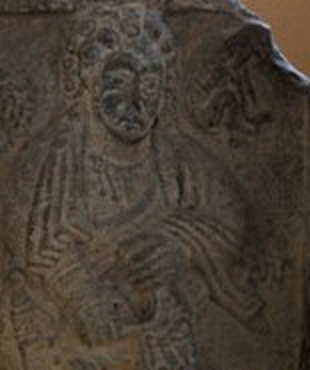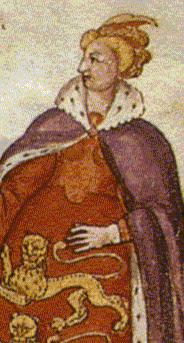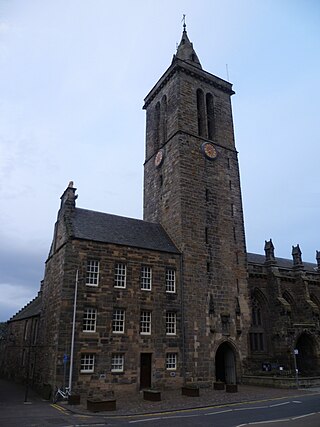Related Research Articles

James III was King of Scots from 1460 until his death at the Battle of Sauchieburn in 1488. He inherited the throne as a child following the death of his father, King James II, at the siege of Roxburgh Castle. James III's reign began with a minority that lasted almost a decade, during which Scotland was governed by a series of regents and factions who struggled for possession of the young king before his personal rule began in 1469.

Alexander Stewart, Duke of Albany, was a Scottish prince and the second surviving son of King James II of Scotland. He fell out with his older brother, King James III, and fled to France, where he unsuccessfully sought help. In 1482 he invaded Scotland with the army of King Edward IV of England and assumed control of the country. Scottish lords turned against him in 1483 and he fled after King Edward died. The second invasion, in 1484, was not supported by the new English king, King Richard III, and failed. He died in a duel with Louis XII of France, Duke of Orléans, by a splinter from Louis's lance.

Óengus son of Fergus was king of the Picts from 732 until his death in 761. His reign can be reconstructed in some detail from a variety of sources. The unprecedented territorial gains he made from coast to coast, and the legacy he left, mean Óengus can be considered the first king of what would become Scotland.

Joan of the Tower, daughter of Edward II of England and Isabella of France, was Queen of Scotland from 1329 to her death as the first wife of David II of Scotland.

Scotland in the Middle Ages concerns the history of Scotland from the departure of the Romans to the adoption of major aspects of the Renaissance in the early sixteenth century.
Norman Macdougall is a Scottish historian who is known for writing about Scottish crown politics. He was a senior lecturer in Scottish history at the University of St Andrews.

Richard William Barber is a British historian who has published several books about medieval history and literature. His book The Knight and Chivalry, about the interplay between history and literature, won the Somerset Maugham Award, a well-known British literary prize, in 1971. A similarly-themed 2004 book, The Holy Grail: Imagination and Belief, was widely praised in the UK press, and received major reviews in The New York Times and The New Republic.

Sir Andrew Wood of Largo was a Scottish sea captain. Beginning as a merchant in Leith, he was involved in national naval actions and rose to become Lord High Admiral of Scotland. He was knighted c. 1495. He may have transported James III across the Firth of Forth to escape the rebels in 1488.
Margaret was a Scottish warship of the 16th century.
Joseph Stevenson was an English Church of England and later Catholic priest, archivist and editor of historical texts.
Anne Elizabeth Curry is an English historian and Officer of Arms.

Scotland in the late Middle Ages, between the deaths of Alexander III in 1286 and James IV in 1513, established its independence from England under figures including William Wallace in the late 13th century and Robert Bruce in the 14th century. In the 15th century under the Stewart Dynasty, despite a turbulent political history, the Crown gained greater political control at the expense of independent lords and regained most of its lost territory to approximately the modern borders of the country. However, the Auld Alliance with France led to the heavy defeat of a Scottish army at the Battle of Flodden in 1513 and the death of the king James IV, which would be followed by a long minority and a period of political instability.

"Of Ane Blak-Moir" is a short poem in Scots by William Dunbar.

Scottish society in the Middle Ages is the social organisation of what is now Scotland between the departure of the Romans from Britain in the fifth century and the establishment of the Renaissance in the early sixteenth century. Social structure is obscure in the early part of the period, for which there are few documentary sources. Kinship groups probably provided the primary system of organisation and society was probably divided between a small aristocracy, whose rationale was based around warfare, a wider group of freemen, who had the right to bear arms and were represented in law codes, above a relatively large body of slaves, who may have lived beside and become clients of their owners.

Education in early modern Scotland includes all forms of education within the modern borders of Scotland, between the end of the Middle Ages in the late fifteenth century and the beginnings of the Enlightenment in the mid-eighteenth century. By the sixteenth century such formal educational institutions as grammar schools, petty schools and sewing schools for girls were established in Scotland, while children of the nobility often studied under private tutors. Scotland had three universities, but the curriculum was limited and Scottish scholars had to go abroad to gain second degrees. These contacts were one of the most important ways in which the new ideas of Humanism were brought into Scottish intellectual life. Humanist concern with education and Latin culminated in the Education Act 1496.

Education in Medieval Scotland includes all forms of education within the modern borders of Scotland, between the departure of the Romans from Britain in the fifth century, until the establishment of the Renaissance late fifteenth century and early sixteenth century. Few sources on Scottish education survived the Medieval era. In the early Middle Ages, Scotland was an oral society, with verbal rather than literary education. Though there are indications of a Gaelic education system similar to that of Ireland, few details are known. The establishment of Christianity from the sixth century brought Latin to Scotland as a scholarly and written language. Monasteries served as major repositories of knowledge and education, often running schools.

Women in Medieval Scotland includes all aspects of the lives and status of women between the departure of the Romans from North Britain in the fifth century to the introduction of the Renaissance and Reformation in the early sixteenth century. Medieval Scotland was a patriarchal society, but how exactly patriarchy worked in practice is difficult to discern. A large proportion of the women for whom biographical details survive were members of the royal houses of Scotland. Some of these became important figures. There was only one reigning Scottish Queen in this period, the uncrowned and short-lived Margaret, Maid of Norway.
Frances Elizabeth Andrews is a British historian who is professor of medieval history at the University of St Andrews. She is a specialist in the medieval church and its networks.

Catherine A. M. Clarke is a British academic. She serves as the Chair in the History of People, Place and Community at the Institute of Historical Research, School of Advanced Study, University of London, where she is Director of the Centre for History of People, Place and Community and Director of the Victoria County History. She is a specialist in the Middle Ages and has published on power, place and identity in medieval Britain.
References
- ↑ "Katie Stevenson".
- ↑ "New Keeper of Scottish History and Archaeology at National Museums Scotland".
- ↑ "School of History". st-andrews.ac.uk.
- ↑ Power and Propaganda, Scotland 1306-1488. Edinburgh University Press. 2014.
- ↑ "The Royal Society of Edinburgh - Early Career Prizes". royalsoced.org.uk.
- ↑ Stevenson, Katie (2004). "The Unicorn, St Andrew and the Thistle: Was there an Order of Chivalry in Late Medieval Scotland?". The Scottish Historical Review. 83: 3–22. doi:10.3366/shr.2004.83.1.3.
- ↑ "Medieval Scottish History Podcasts - The Historical Association". history.org.uk. 22 December 2014.
- ↑ "Katie Stevenson". lrb.co.uk.
- ↑ Thomas Jeatt for Taylor & Francis. "Cogent Arts & Humanities Editorial Board Members". cogentoa.com. Archived from the original on 18 February 2015. Retrieved 18 February 2015.